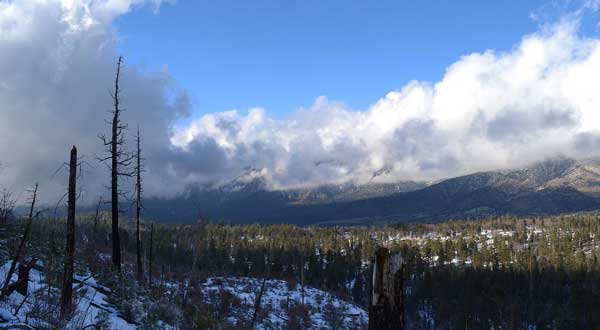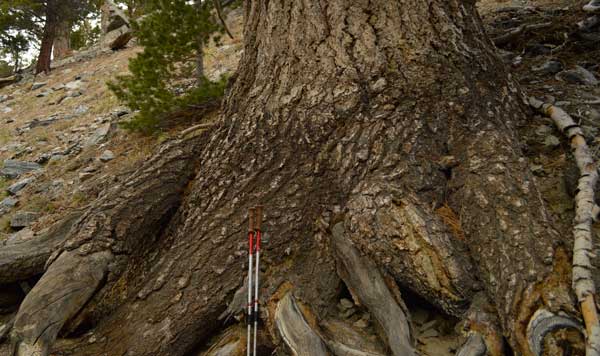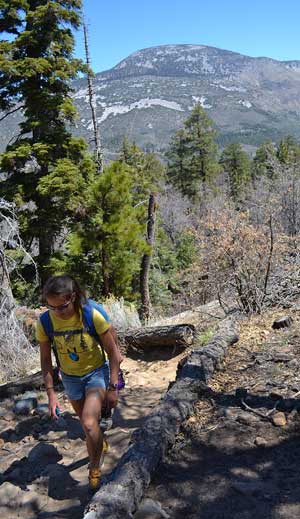
What makes a place a home?
This can be a tough question. Think about it for a moment. When you say, “I feel like I’m at home” what makes you feel that way? 2,000 years ago when the Yuhaviatam arrived in the San Bernardino Mountains they built the first human homes in the area. The primary purpose of these simple shelters was to provide protection against the elements. They lived most of their lives outdoors, and only went into a shelter in cases of extreme weather.
Today our homes provide even better shelter from cold and heat due to modern conveniences. However, to many people a home is more than just a shelter. A home is somewhere special because it is your space. You know you have everything you need, you know what each room looks like, and you know where everything is (or at least where it should be). Although it can be defined in many ways, I believe that it is this comfort and familiarity that makes a house a home.
Unfortunately for many students, the forest ecosystem at High Trails is very far from home. Even though some students have seen or visited the mountains before, it is still unfamiliar, and can feel like a hostile environment. For those whose trek to High Trails is their first time away from the city, it can be easy to feel uncomfortable and homesick. Here are a few tips and tricks to enhance common activities in order to help these students feel more at home while in the woods.
Hug A Tree
Hug a Tree is the first of these activities; often one that students participate in on their first day. Students will be with a partner, preferably someone they trust. This partner will blindfold them and then lead them to a tree. Once they are safely at the tree, the partner who led them there will return to the circle. At the circle we will discuss students’ previous experience with trees, talk about fun facts or jokes. The students who are blindfolded by a tree will take this time to really get to know their tree. This entails feeling the bark above them and the bark all the way down to the ground. It requires tasting the tree, smelling the tree, feeling what is around the tree, and finally finding the perfect spot for their back to lean up against the tree. Once this spot has been found, they can sit there in silence and listen to their tree. If they listen carefully enough, sometimes they will be able to hear the tree talking to them (really!).

After the instructor has decided that each student has had enough time with their tree, they will send the student’s buddies to find them and bring them back to the circle. Once back in the circle the blindfold will be removed and they can try to find their tree. Then partners will switch. After everyone has had a chance to find a tree, instructors can teach them how to describe the attributes of their tree. Students must return to their tree and give it a name based on its attributes. At the end of the activity everyone will have a chance to share their tree’s name and reasoning behind it with the group. This simple exploration gives them something in the forest that they feel somehow belongs to them- now they have their own special tree. It also familiarizes them with the small details of the trees around them, and suddenly their surroundings don’t seem quite so strange.
Adopt A Plant
 Other activities we do throughout the week continue to develop these important observational skills which help students feel more engaged and at home in the forest. Asking thought-provoking questions during these activities can help keep them, both entertaining and meaningful. In plants class, adopting a tree is similar to the first day hug a tree activity. However, this time students must pay close attention visually to accurately draw and describe all the characteristics of a tree. They may have a contest to see who can create the most detailed drawing or ask students to come up with five different adjectives that accurately portray their tree.
Other activities we do throughout the week continue to develop these important observational skills which help students feel more engaged and at home in the forest. Asking thought-provoking questions during these activities can help keep them, both entertaining and meaningful. In plants class, adopting a tree is similar to the first day hug a tree activity. However, this time students must pay close attention visually to accurately draw and describe all the characteristics of a tree. They may have a contest to see who can create the most detailed drawing or ask students to come up with five different adjectives that accurately portray their tree.
Eye For Erosion
Another activity, Eye for Erosion, makes students start looking at the geologic features of the area. Once they know what to look, for have them keep finding good examples of erosion throughout the day. For instance it can become a fun hiking competition to try and find the biggest exposed roots along the trail.

Camouflage
 Even everyone’s favorite game of Camouflage can be used as an opportunity to have students look closer at the world around them. After the game is over, have students point to someone in the group whose clothes provide good camouflage, and then point to someone whose clothes don’t blend in with the forest. Then have each student return to their hiding place and find a real living organism that is camouflaging there. 99% of the time, they didn’t notice that creature the first time.
Even everyone’s favorite game of Camouflage can be used as an opportunity to have students look closer at the world around them. After the game is over, have students point to someone in the group whose clothes provide good camouflage, and then point to someone whose clothes don’t blend in with the forest. Then have each student return to their hiding place and find a real living organism that is camouflaging there. 99% of the time, they didn’t notice that creature the first time.
Scavenger Hunt
 Between classes or during water and happy tree breaks, an on-going scavenger hunt is an awesome way to keep students engaged and constantly observing the forest. “Find a bird that is singing.” “Find a creature that walks on 2 legs, a creature that walks on 4, and a creature that walks on 8.” By the end of the week, we can hope that students will feel a bit more at home in the forest because they have formed personal connections with trees birds and spiders, and because they are familiar with all of its nuances.
Between classes or during water and happy tree breaks, an on-going scavenger hunt is an awesome way to keep students engaged and constantly observing the forest. “Find a bird that is singing.” “Find a creature that walks on 2 legs, a creature that walks on 4, and a creature that walks on 8.” By the end of the week, we can hope that students will feel a bit more at home in the forest because they have formed personal connections with trees birds and spiders, and because they are familiar with all of its nuances.
 Of course, we can dream that each of our students will develop plans of action to save the environment, go home and start community service projects. But since we only have one week with them, this might not happen. What we can teach them is that the woods aren’t an alien landscape. We can plant a spark, a week of good woodland memories, and the idea that a forest can be a home: somewhere you want to come back to, somewhere you want to spend time in, and somewhere you certainly don’t want to destroy. If we do our job right, in time our students will return to these woods, visit others, and build more good memories and connections. Perhaps one day they will work to protect and preserve them for others to enjoy.
Of course, we can dream that each of our students will develop plans of action to save the environment, go home and start community service projects. But since we only have one week with them, this might not happen. What we can teach them is that the woods aren’t an alien landscape. We can plant a spark, a week of good woodland memories, and the idea that a forest can be a home: somewhere you want to come back to, somewhere you want to spend time in, and somewhere you certainly don’t want to destroy. If we do our job right, in time our students will return to these woods, visit others, and build more good memories and connections. Perhaps one day they will work to protect and preserve them for others to enjoy.
At High Trails Outdoor Science School, we literally force our instructors to write about elementary outdoor education, teaching outside, learning outside, our dirty classroom (the forest…gosh), environmental science, outdoor science, and all other tree hugging student and kid loving things that keep us engaged, passionate, driven, loving our job, digging our life, and spreading the word to anyone whose attention we can hold for long enough to actually make it through reading this entire sentence. Whew…. www.dirtyclassroom.com

Comments are closed.